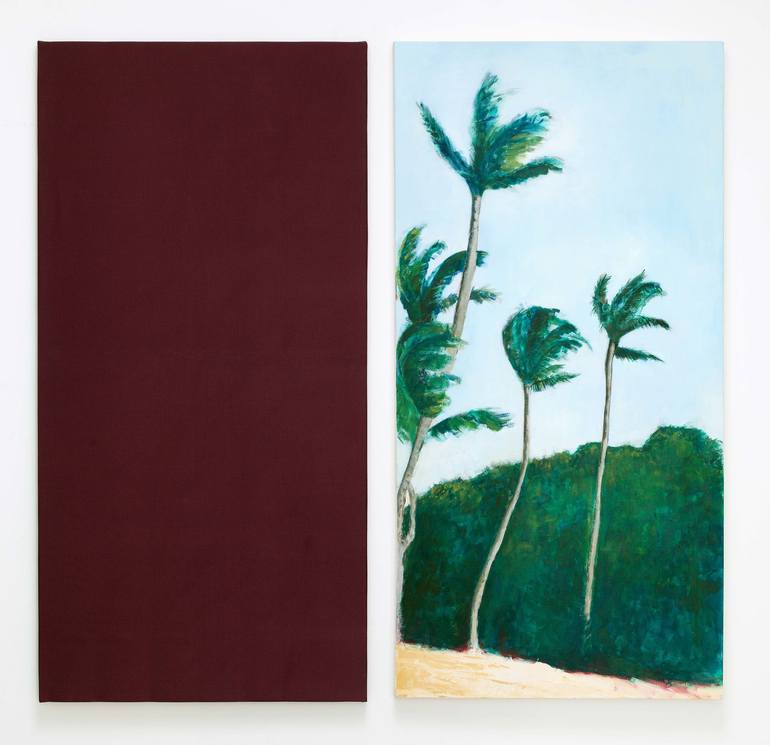


VIEW IN MY ROOM
Burgundy and Palms Painting
Germany
Painting, Acrylic on Canvas
Size: 23.5 W x 47.5 H x 0.1 D in
Ships in a Tube
Artist Recognition

Artist featured in a collection
About The Artwork
In the diptych representing a beach on the Samaná Peninsula in the Dominican Republic, two different elements come together to capture an impressive moment. The first part of the diptych consists of a stretcher frame covered with a burgundy cotton cloth. The deep red color of the cloth captures the viewer's attention and creates a warm, sensual atmosphere. It adds depth and a touch of elegance to the artwork. In the second part of the diptych, the viewer is transported into a picturesque scene showcasing a golden sandy beach and turquoise sea. The tall palm trees swaying in the wind shape the landscape and convey a sense of tropical beauty and tranquility. Within this painterly setting, nuances of burgundy accents can be observed. The colors of the cloth are reflected in the shadows of the palm trees and in the gentle shades of the sunset. These subtle burgundy accents create harmony and a visual contrast to the vibrant colors of the beach and the sea. The combination of the burgundy fabric and the depiction of the idyllic beach with palm trees creates an interesting tension between abstraction and realism, between the intimacy of the cloth and the vastness of nature. These contrasts make the diptych an artwork that appeals to the senses and transports the viewer into a world of beauty and serenity.
Details & Dimensions
Painting:Acrylic on Canvas
Original:One-of-a-kind Artwork
Size:23.5 W x 47.5 H x 0.1 D in
Frame:Not Framed
Ready to Hang:Not applicable
Packaging:Ships Rolled in a Tube
Shipping & Returns
Delivery Time:Typically 5-7 business days for domestic shipments, 10-14 business days for international shipments.
Handling:Ships rolled in a tube. Artists are responsible for packaging and adhering to Saatchi Art’s packaging guidelines.
Ships From:Germany.
Customs:Shipments from Germany may experience delays due to country's regulations for exporting valuable artworks.
Have additional questions?
Please visit our help section or contact us.
Germany
I was born in an old, large house with high ceilings and eleven rooms in the city of Lima. There my parents lived with my seven brothers. The smell of the good seasoning of the dishes prepared by my mother and the smell of oil, water, terpentine are mixed in my memory. In one of the spaces my dad had his desk, his books, his materials and his easel: he was a painter and his subject was the portrait. With the still lifes that our father put together, my relationship with art began. My father read a lot and knew the history of art very well, his stories, his anecdotes were always fuelling my curiosity to see other worlds, relate to other cultures and see live the works of the great masters. That's how I came to Germany with the illusion of studying at an art school and visiting the great museums. For two years I visited the Städelsches Art Institute in Frankfurt, Germany. In that city I met my husband, who continues to accompany me in this beautiful adventure and I brought my best creation to the world: Rainer and Silke, my children. I returned to my studies at the National School of Fine Arts in Lima and I was fortunate to have as a teacher the artist Miguel Angel Cuadros who not only knew how to teach the different pictorial techniques but also knew how to transmit the principles that the artist must have before his work and his audience My husband worked in development projects and for that reason I have been in different countries in Latin America, always having as a place of residence the city of Berlin. This experience has enriched me as a person and influenced my work. At the University of the Arts in Berlin I did a master's degree. The study was aimed at cultural work with young people and children. Feeling the nostalgia of living far from Peru and knowing the difficult situation that was lived in the era of terrorism, my first works were figurative with a strong social burden and denunciation. The pre-Hispanic cultures were always my fascination and I have dedicated many works dealing with these issues, concrete case El Pallar (Lima Bean). An image that has an important presence in the iconography of pre-Hispanic cultures. Without realizing, the human figure was disappearing from my canvas to make way for the space of the deserts. The desert occupies a considerable part of the Peruvian territory and was the cradle of important pre-Hispanic cultures; with this topic I have been working the last twenty years.
Artist Recognition

Artist featured by Saatchi Art in a collection
Thousands Of Five-Star Reviews
We deliver world-class customer service to all of our art buyers.
Global Selection
Explore an unparalleled artwork selection by artists from around the world.
Satisfaction Guaranteed
Our 14-day satisfaction guarantee allows you to buy with confidence.
Support An Artist With Every Purchase
We pay our artists more on every sale than other galleries.
Need More Help?